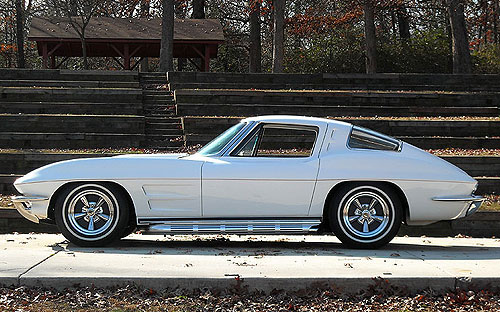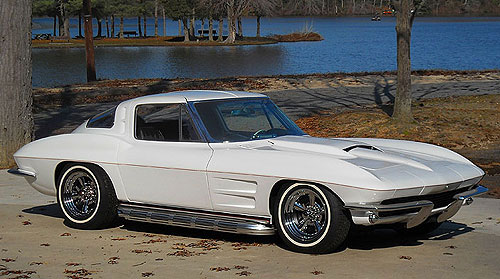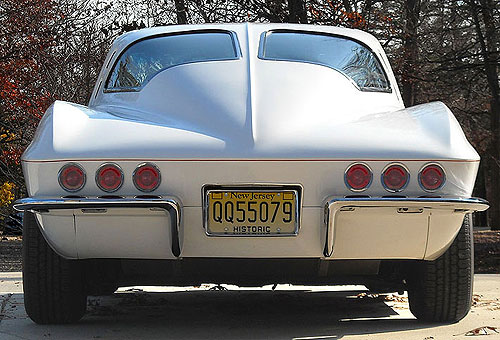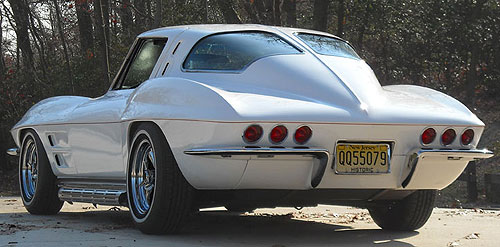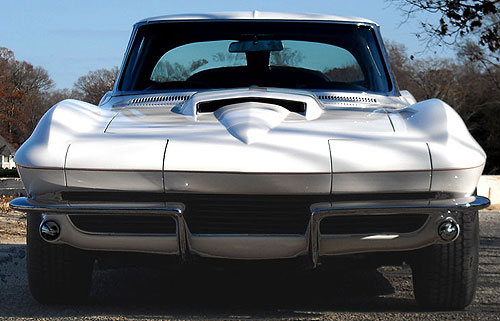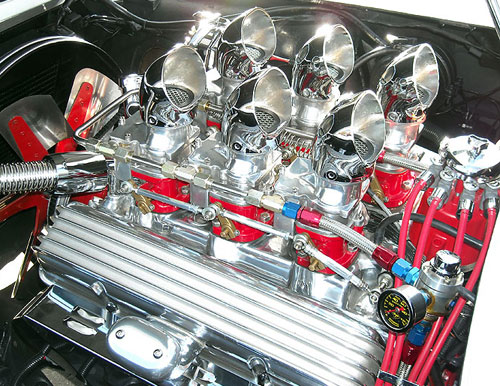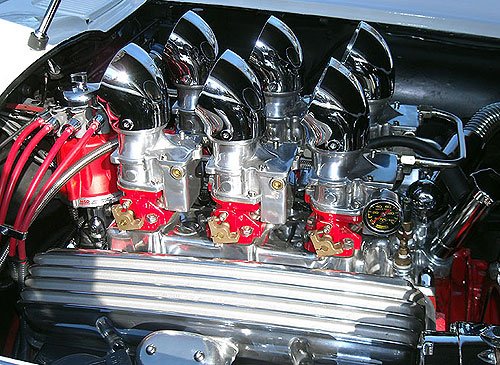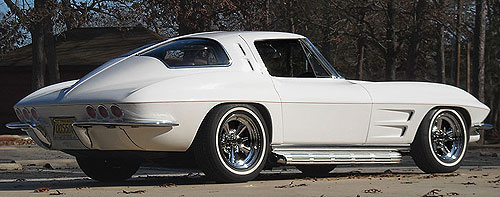Stricken With Seller’s Remorse, New Jersey Corvette Fan, Jonathan Settrella Creates His Ideal Corvette… Again!
Settrella’s custom Sting Ray received the “shaved” look. See any door handles?
I met Jonathan Settrella in 1975 at an art show in Moorestown, New Jersey. We struck up a conversation and it turned out that Jon had a Corvette – a customized, ‘63 Split-Window Coupe. We hung out occasionally and used to see one another at various art shows. But as the ‘70s and ‘80s wore on, life got in the way and I lost touch with my artist/car friend.
Fast forward to September ‘09 at the Weaton Village Vettes At Glasstown Show in Millville, NJ. I looked up and saw a car I hadn’t seen in nearly 30 years! I said to my wife, “I know that car!” Sure enough, it was my old pal, Jonathan Settrella. After catching up, I said, “Jonathan, I can’t believe you STILL have the ‘63 Coupe.” He replied, “This is a replica of the car you saw way back when.” Sensing a story, I said, “Okay, so what happened?” It turned out to be a classic tale of sellers remorse. In Settrella’s case, it was MAJOR remorse. But first, lets back up about 40 years.
’60s classic Astro Supreme mag wheels and white wall tires nail that early-to-mid ’60s custom look.
Settrella grew up in rural Glassboro, New Jersey, a sleepy town famous for two things – a state college and the location of the famous Lyndon B. Johnson – Aleksei Kosygin summit talks in 1967. His passions growing up were cars, racing, art, and Corvettes. After completing art school, Jonathan settled into a career as a commercial artist, got married, and started a family. But not before sowing some wild oats in the raucous world of dirt track racing.
Settrella’s dream Vette was a ‘63 split-window coupe. By the time he was able to buy one, ‘63 Sting Rays were very reasonably priced. An artist friend sold him a Ermine White ‘63 Coupe with a four-speed. As his kids grew up, they fell in love with the Sting Ray as much as their Dad. It wasn’t long before the artist in Jonathan wanted to personalize his ride. So in ‘68, he started his gradual customization of his Corvette. Back then, cutting up and changing a late model Corvette was sacrilege, as it is today. What started out as a simple dechroming project, gradually became a full custom road car. Even though Corvettes aren’t family cars, Jonathan and his family thoroughly were into this car. His daughter, Donna used to love to lay in the back cargo area and watch clouds roll by. His son, Jonathan Jr. dreamed of one day owning the car.
The eatra tail lights was almost “standard” for custom Vettes back in the day.
Now, back to that seller’s remorse part. It was 1980 at the same Wheaton Village car show, Settrella was showing his custom Vette. A young fellow kept hanging around the car – obviously he liked the car a lot. Eventually, he asked, “How much do you want for your car?” “It’s not for sale.” Jonathan replied. But the guy kept asking. In hopes of putting the guy off, Settrella answered, “$15,000!” (A new Vette in 1980 had a base price of $13,140!) And to his shock, the young man said, “Sold! Can I pick it up tomorrow?”
Settrella didn’t believe the guy because he was very young and it looked like he was just trying to impress the gal on his arm. But much to Jonathan’s dismay, the next day, the young fellow showed up with $15,000 CASH! “It felt like a dope deal from the movie Scarface!” Jonathan said. “Do you have tags and insurance?” Jonathan asked. “No, I’ll be okay.” replied the young guy, and off he went. “And that’s the last time I ever saw the car or heard from the guy.” said Settrella.
Settrella felt that the Sting Ray sat just a bit tall, so he lowered the car 2-inches.
The remorse was immediate. When his daughter learned that her Dad sold the Corvette she cried. It took a long time for the kids to get over it and there was a part of Jon that never got over it. Years later, after a prestigious career in commercial art, Settrella retired in 2005. During that time, Jonathan bought and sold dozens of Corvettes and Mustangs as a hobby. With plenty of time on his hands and a nice retirement nest egg, Settrella set out to take care of that nagging seller’s regret feeling over the ‘63.
By this time, Jonathan, Jr. was an accomplished painter/car customizer, so it didn’t take too much coaxing to recruit his son to help with his latest project – to build another custom ‘63 Split-Window coupe. With lots of photographs of the original car, the project was started in early ‘07 and completed by September of that year. Split-window coupes cost a whole lot more in ‘07 than they did in the late ‘60s. The hard part was finding a ‘63 Coupe that was complete enough, but not so special that it shouldn’t be modified. The best he could find was former drag racer for $35,000.
The ‘63 Sting Ray had been sitting on a trailer for 14 years. Aside from a lot of dirt and neglect, the car was in pretty good condition. Early C2s were criticized for being over decorated, so Settrella removed a lot of the fru-fru. Jonathan Jr. did the paint and body work to replicate the popular dechroming look from the ‘60s. The “shaved look” included the removal of the door handles, the windshield wipers, and gas cap. The windshield cowl vents were customized to eliminate the opening for the wipers and the stock gas filler cap was removed and relocated behind the rear license plate. The ‘67 big-block hood design is just too beautiful to not have on a custom, and cleaner-looking than the stock ‘63 hood with its fake hood vents.
Note the blacked-out grille and the “for display only” chrome caps over the turn signal lens.
Most obvious is the lack of door handles. How do you get into the car? This is a “drive and don’t leave unattended” car, as the windows must be down to open the doors. Also note the total absence of any badges on the body. Another classic ‘60s custom touch is the extra set of rear taillights. More subtle details include black accents where vent openings should be on the front fender and B-pillar vents and a thin red pinstripe to accent the horizontal body crease. The front grille is blacked out and chrome caps cover the front turn signals for show purposes. And lastly, the side window vent frames are painted flat black.
Settrella’s 327 small-block looks like it’s using classic Stromburb carbs. NO WAY! This is a full-fledged, computerized, modern fuel-injection setup!
Under the hood, the 327 small-block engine is a visual mix of red and chrome parts with anodized red and blue fuel fittings, and red ignition wires. At first glance, one is compelled to say, “Wow! Look at those six Stromburg ‘97’s!” But this is no carb setup from 50 years ago. What looks like Stromburg carbs atop the Offenhauser aluminum manifold is actually a cutting-edge fuel-injection system that uses six throttle-bodies with twelve electronic injectors driven by a computer mounted in the interior’s glove box. As classic-looking as the setup is, Jonathan admits that it was very difficult to setup, but worth the effort. Ignition chores are handled with an MDS ignition and a 50,000-volt Blaster coil mounted in the glove box. Exhaust manifolds are stock cast iron with side-mounted exhaust pipes mated to Cherry Bomb mufflers under the ‘65-’67 side-pipe covers.
Note the “no-name” valve covers. It’s a classic ’60s look and fits with Settrella’s overall custom theme and a total absence of any branding.
Since the car had been a drag racer, the suspension was in pretty good shape and only needed refreshed shocks and bushings. Settrella lowered the car 2-inches by clipping the front springs and installing longer rear shackles. Since the differential was deemed in good condition, the 4.11:1 gearset and stock anti-sway bar were kept. With a considerable amount of power and the quick accelerating gear set, Settrella installed all new carbon-metallic brakes and brake lines for proper stopping power. One of the more distinctive aspects of Settrella’s ride are the vintage Astro Supreme chrome mag wheels, shod with 205/70R15 Uniroyal whitewall tires.
The chrome gizmo mounted on the top center of the dash isn’t a fire extinguisher. It’s a repro manual fuel pump – a salute to Settrella’s dirt track racing days.
As with the rest of Settrella’s ride, the interior is festooned with custom touches. Stock mid-year seats were replaced with Carrera bucket seats for more lateral support. The dash features new tach, gas, and fuel gauges. While the shifter linkage is from Hurst, the shifter is stock and the steering wheel is a custom billet piece. Settrella substituted the glove box button, center dash controls, and driver’s seat adjuster with custom chrome balls. And lastly, the unusual-looking cylinder atop of the dash is a mock-manual fuel pressure pump, a throwback to Jon’s old dirt track racing days. Once a racer, always a racer.
Settrella and son completed the car in just six months, just in time for its first outing in September 2007. Jonathan’s daughter, now all grown up with a family of her own, did not know about the ‘63 custom rebuild. When she saw the car for the first time she cried. “You got it back?” “No, I built another one.” her Dad replied.
This is a parting view that Setttrella NEVER intends to ever see again!
We mentioned that Settrella is a serious artist/car guy. For most normal guys, a car such as this would be “it.” However, Settrella also owns a ‘33 Alloway Speedstar street rod, a ‘37 Wild Rod street rod with a 454 Chevy engine, a ‘95 Pontiac Trans-Am, a stock ‘69 SS/RS Camaro, a ‘76 Greenwood wide-body Can-Am Corvette, as well as a ‘78 Silver Anniversary Corvette.
As with all custom cars, they are never really “finished.” But Jon’s “to-do” list for his ‘63 Sting Ray is indeed short. But Jonathan has promised his family one important thing, “I WON’T SELL IT!”
KST
PS – This article ran in the April 2011 issue of VETTE Magazine. When I sent in my article package to VETTE’s editor, Jay heath, I included many more images than were used for the magazine story. Below are ALL of the images I sent. Enjoy!
[nggallery id=8]

